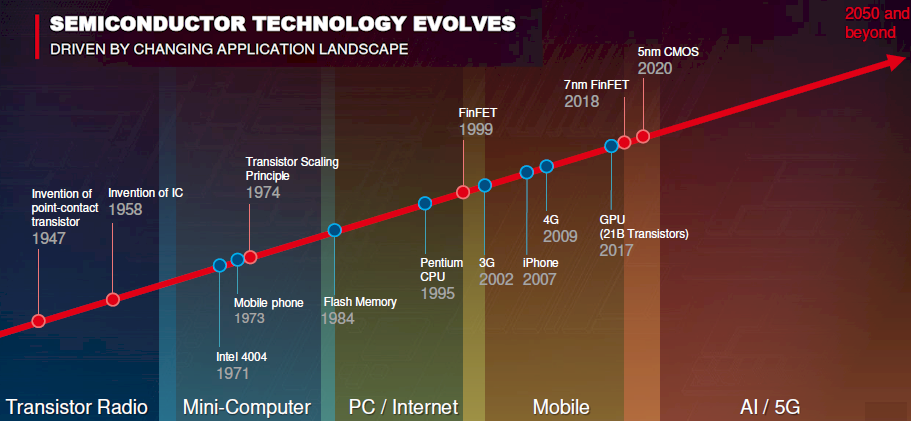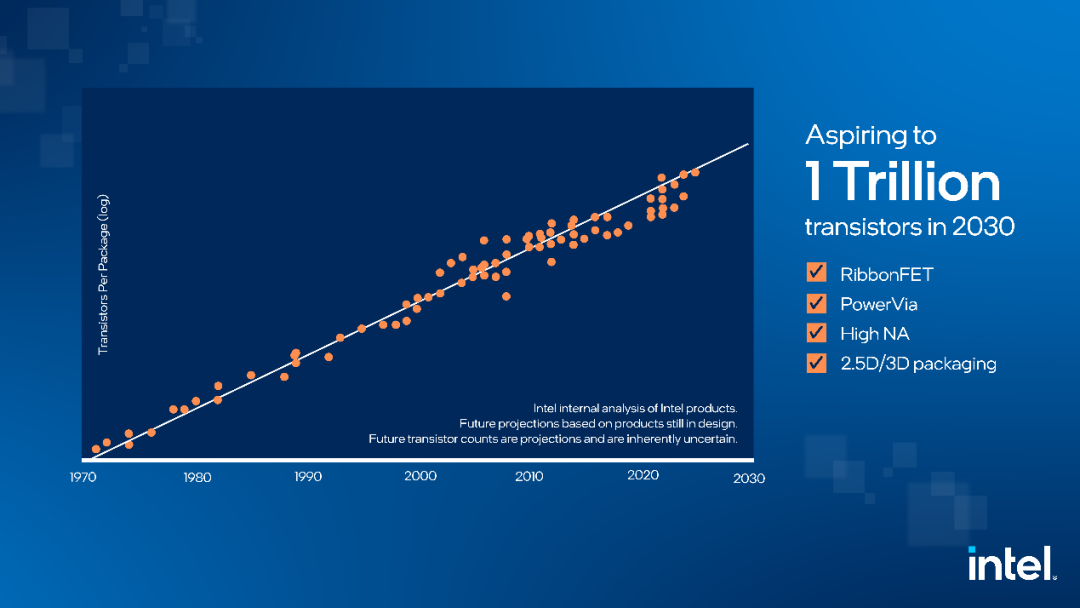In April 1965, Electronics Magazine published an article by Intel co-founder Gordon Moore. He observed that the number of transistors on an integrated circuit would double approximately every two years.
This prediction became legendary, eventually known as Moore’s Law—a principle that shaped decades of semiconductor innovation and defined the pace of the computing revolution.
But six decades later, the industry is divided: who can truly carry forward Moore’s Law?

Intel: Once the Guardian of Moore’s Law #
Since its founding in 1968, Intel became synonymous with “shrink.” Every two years, it delivered new generations of transistors at half the size, doubling chip density while keeping costs stable. This enabled Intel to dominate both the memory and microprocessor markets.
Yet, in recent years, Intel has faltered. After back-to-back disastrous earnings reports, Intel’s market value plummeted from $210 billion in January to just $84 billion, falling below the value of its factories and equipment. For the once-unquestioned guardian of Moore’s Law, these are unprecedented times.
So the question arises—who inherits Moore’s Law now?
Nvidia: The Rise of Huang’s Law #
Nvidia has long challenged the relevance of Moore’s Law.
Back in 2010, Bill Dally, Nvidia’s Chief Scientist, declared Moore’s Law dead, claiming that parallel computing, not CPUs, would drive the future. GPUs, with their ability to scale cores efficiently, could deliver exponential performance while managing power consumption.
At the 2018 GPU Technology Conference (GTC), Nvidia CEO Jensen Huang doubled down, introducing what became known as “Huang’s Law”: GPU performance grows far faster than Moore’s Law suggests. He highlighted examples:
- Nvidia GPUs were 25x faster than five years prior.
- Training AlexNet dropped from 6 days (GTX 580) to 18 minutes (DGX-2)—a 500x improvement.
Huang argued that GPUs benefit from holistic innovation—architecture, interconnects, memory, and algorithms—not just transistor density.

But Huang’s Law is more marketing slogan than scientific rule. Studies show GPU cost-performance (FLOPS per dollar) only doubles every 2.5 years, slower than Nvidia’s claims. In reality, GPU gains are still deeply tied to process node advances—the very essence of Moore’s Law.
TSMC: Moore’s Law Is Alive and Well #
Interestingly, Nvidia’s key foundry partner, TSMC, remains one of the strongest believers in Moore’s Law.
As early as 1998, TSMC founder Morris Chang predicted Moore’s Law would remain valid for decades. In 2019, VP of Research Philip Wong reaffirmed this at Hot Chips:
“It’s not dead. It hasn’t slowed down. It hasn’t even gotten sick.”
TSMC continues to push density through CMOS scaling, FinFETs, and advanced 2.5D/3D packaging. Wong stressed that packaging innovations—chiplets, 2.5D, and eventually full 3D stacking—will sustain Moore’s Law for years to come.
In 2024, TSMC’s Kevin Zhang reiterated:
“We don’t care if people say Moore’s Law is dead. What matters is continuing to pack more functionality, higher performance, and better efficiency into smaller footprints.”

Intel’s Gamble on 18A #
Unlike TSMC’s rise, Intel is fighting to reclaim lost ground. CEO Pat Gelsinger insists Moore’s Law is alive, betting the company’s future on Intel 18A, its most advanced node.
Intel’s roadmap:
- Intel 7 → Intel 4 → 20A → 18A (2025 launch)
- Products: Panther Lake CPUs, Clearwater Forest data center chips, Diamond Rapids CPUs
- Customers: Microsoft and even the U.S. Department of Defense
Gelsinger calls it Intel’s biggest gamble ever:
“I’m betting the entire company on 18A.”
But the cost is enormous—falling stock, weak earnings, and financial strain. Intel’s once-untouchable dominance now faces an uncertain outcome.

Conclusion: Who Will Carry Moore’s Law Forward? #
So, who is the true successor of Moore’s Law?
- Nvidia says Moore’s Law is dead, replacing it with Huang’s Law—but its gains remain tied to node scaling.
- TSMC continues to innovate in process technology and packaging, keeping Moore’s Law alive.
- Intel, the law’s original guardian, is risking everything on 18A to prove it’s not over yet.
The reality: Moore’s Law is slowing, but not dead. Whether it’s GPUs, foundry innovation, or packaging breakthroughs, the semiconductor industry’s survival still depends on relentless technological progress.
In the end, just as Intel once abandoned memory to bet on microprocessors, the future belongs to those bold enough to embrace true innovation.
